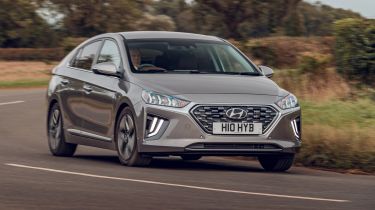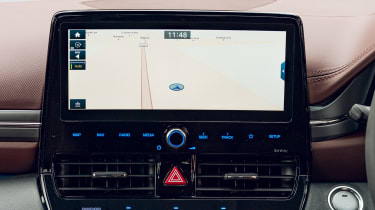Hyundai Ioniq Hybrid (2016-2022) - Interior & comfort
The Hyundai Ioniq has space for five adults and plenty of in-car technology
Like the exterior, the Ioniq’s interior is conventionally styled and as well built as you’d expect from a Hyundai, even if some of the plastics feel a little low-rent, particularly on the doors.
There’s a degree of sharpness to the way the Ioniq copes with poor road surfaces, but for the most part its suspension deals with bumps and ruts well, keeping you and your passengers reasonably well-cushioned against the worst road surfaces. It’s still bumpier around town than we’d like.
Hyundai Ioniq dashboard
Up front, large swathes of dark materials are broken up by electric-blue stripes around the air vents, touchscreen, upholstery and start button. But where the Ioniq impresses is for in-car technology. There’s a seven-inch TFT screen in front of the driver (4.2-inch in the SE model) and an eight-inch touchscreen in the centre console. The latter displays all manner of hybrid and charge-related information and it's compatible with Android Auto and Apple CarPlay (on Premium and Premium SE models), allowing you to use familiar apps.
It's a real shame Hyundai has moved the climate control settings to the touchscreen for the facelift because the physical controls fitted before were more logical and less fiddly, making it a rare step backwards.
Equipment
The Ioniq Hybrid is available in three trim levels: SE, Premium and Premium SE. The entry-level SE model comes equipped with 15-inch alloy wheels, DAB radio, Bluetooth connectivity, cruise control, rear parking sensors and a reversing camera, along with a 10.25-inch touchscreen. There’s also a host of standard safety kit, including autonomous emergency braking (a system that can stop the car automatically in an emergency), lane-keeping assistance and tyre-pressure monitoring for individual tyres.
More reviews
Stepping up to Premium trim level will get you keyless entry and go, heated front seats, a heated steering wheel, bi-xenon headlights and LED rear lights. There’s also satellite navigation, an upgraded stereo and wireless phone charging, as well as compatibility with Android and Apple smartphones.
If you want the top-of-the-range Premium SE model, you’ll have to fork out over £28,000 for the privilege. Do so and your car will come with 17-inch alloys plus automatic wipers and headlights, as well as heated and ventilated leather front seats. You also get power adjustment with a memory setting for the driver’s seat, as well as features like blind-spot monitoring and rear cross-traffic alert (which can warn you of approaching traffic as you’re reversing out of a parking space) as well as front parking sensors.
The Ioniq also has a built-in SIM card, allowing the car to stay online. This brings lots of advantages, from live traffic updates to the ability to connect to your car remotely via a dedicated BlueLink smartphone app, changing settings like the air-con.
Options
As with the rest of the Hyundai range, options are fairly limited on the Ioniq, as standard equipment is pretty comprehensive. You can add metallic paint for around £550, while on the Hybrid, the Premium SE trim level can be specified with 17-inch alloys (which reduce fuel economy and increase CO2 emissions) for £400.













